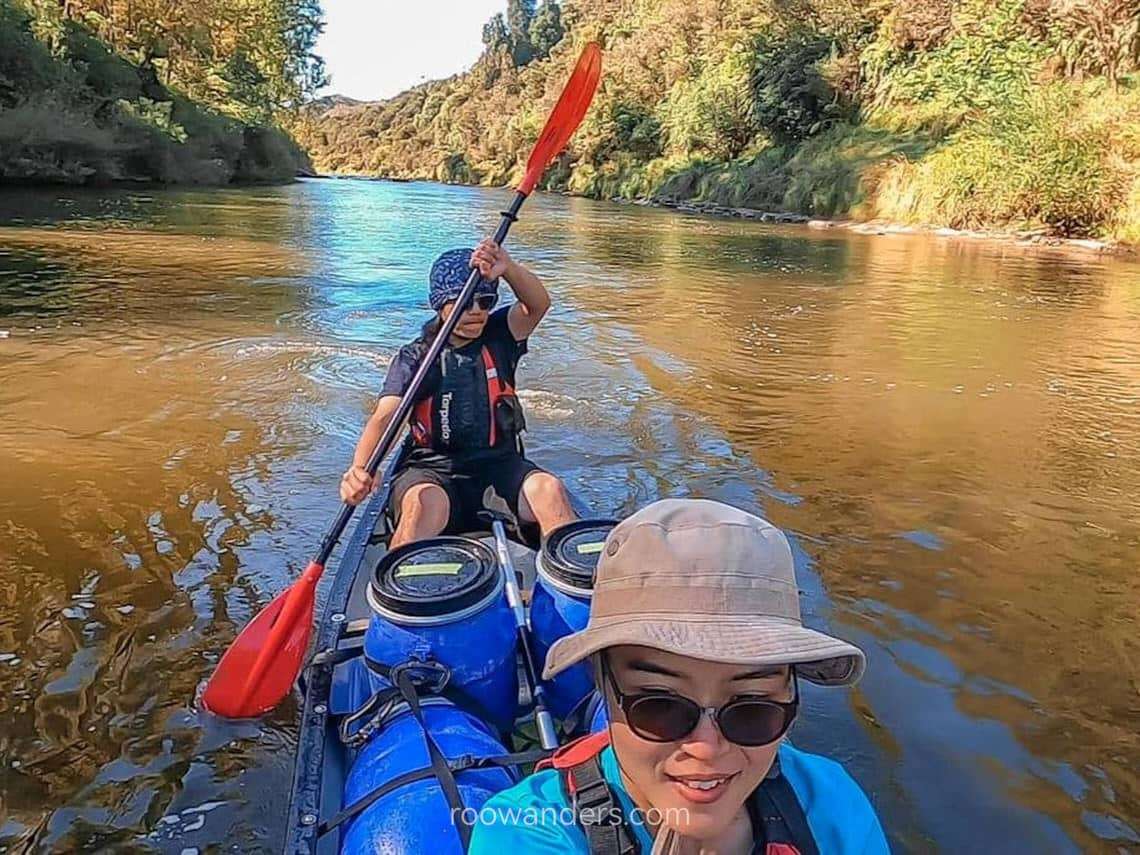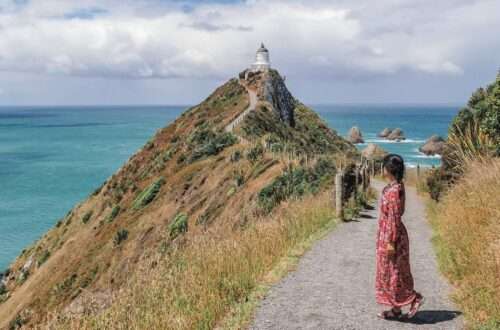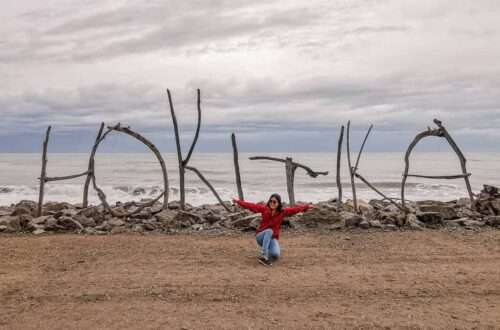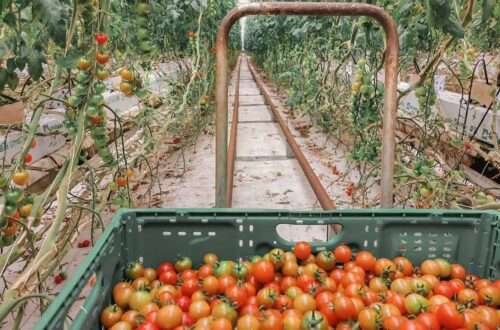
Great Walk Series #8: Whanganui River Track
It is classified as a Great Walk, but really, there isn’t much walking on The Whanganui River Track. Trade those hiking boots, bags and poles for those sandals, paddles and canoe. It is time to get burnt and wet.
The Whanganui River Journey is my eighth Great Walk and one that began as another ended. We went from hiking amongst the volcanoes at Tongariro National Park, to canoeing down a river!
No experience in canoeing? No worries – us too when we started off. Sounds fun? Here’s everything you need to know about paddling down the Great Whanganui River.

I canoed down the Whanganui River in Mar 2021. This post may be updated periodically.
Where is the Whanganui River?
The Whanganui River begins from Mount Tongariro and ends in the Tasman Sea. It is the third-longest river in New Zealand and holds significance to the Maori. While you could potentially paddle through its entirety, only a portion of it – 145 km – is marked as the Great Walk.
The Great Walk begins at Taumarunui and ends at Pipiriki. It takes an average of eight hours of paddling every day for five days to cover the track. However, the best and most remote part of the track is between Whakahoro and Pipiriki – Day 3 to 5 of DOC’s official guide. Given our time constraints, we chose to start our journey at Ohinepane.
History of the Whanganui River
The Whanganui River was once a major transport route across the North Island.
Indigenous Maori tribes first lived on the land until the European settlers crept in and massively transformed the river into a trading route. Conflicts ensued while towns flourished. An abandoned stone bridge in the middle of the river track served as a highlight of the trip.
Best Time to Visit Whanganui River
Unlike the other Great Walks where a good pair of hiking shoes should suffice, the Whanganui River Track requires a canoe or a kayak, which is not an essential item for any wandering backpacker. There are rental shops in towns around the track, but most would operate only during the peak season. Check beforehand.
You should only attempt during the off-season if you are adept and confident. Heavy rains could lead to an unpredictable and dangerous river.
We paddled through the track in March. The best time to go would be in late spring to early autumn when the weather is still relatively warm.

Getting to the Whanganui River
The best places to station yourself would be Ohakune, Raetihi or Taumarunui. As we happened to complete our seventh Great Walk – Tongariro – the day before, Ohakune was the closest and most convenient spot for us to rest before Wanganui.
We stayed in a lodge, ate some fantastic burgers – shout-out to the Blind Finch (no longer serving burgers anymore 🙁) – and made reservations for our trip in one of the canoe rental shops in Ohakune. Our rental shop provided a shuttle to and from the entry and exit points.
Buffer NZD 180 – NZD 210 for your rental.
Accommodation along the Whanganui River
Campsites are aplenty – there are 11 – on this track, and only three huts. It costs NZD 30 for a bunk bed and NZD 16 for a campsite per person per night during the peak season. Off-season prices are halved. You could use backcountry hut passes during the off-season.
My Whanganui River Experience in Brief
DOC designates a portion of the river for the Great Walk, and it takes at least five days to complete the whole track. We skipped the first day – Cherry Grove, Taumarunui to Ohinepane campsite (3 – 5 hours, 22 km) – and started our adventure on Day 2 of DOC’s guide. According to the paddlers we met on the trip, the first day was the most challenging with several fast rapids. Farmland takes most of what they saw.
Day 1: Ohinepane to Whakahoro (35 km, 6 – 8 hours, we took 10 hours)
Packing and Briefing
Our day began with depositing our car in the canoe rental shop. We received a briefing from the shop a day before and packed our necessities in the six barrels provided by the shop as part of the package.
What did you pack in the barrels? Food for four days and more, clothes, sleeping bags and mats, and cooking utensils. We strapped our tent over the barrels.
Along with the barrels, we were also given life vests, a cooler bin, a locator beacon, a small waterproof black box and maps.
One of the staff drove us from Ohakune to Ohinepane. It took us about an hour and a half, including a toilet break at Taumarunui, via Highway 4, then 43.
It was a sunny day, forecasted to remain sunny until the later part of our journey.

Noobcakes on the River
Our driver dropped our items by the campsite and taught us to secure the loose items onto the canoe. He gave us a 5 mins crash course on manoeuvring the canoe. I was the navigator and sat at the front. My role was to spot the obstacles and find the right course. My partner was the propeller and the person to stir the canoe towards the right path. Finding the right partner to team up with is very important.
Communication is the key to preventing most tumbles.
It was showtime for us – canoe noobs with less than an accumulative eight hours of kayak experience under their belts respectively.
The first day was challenging for a newcomer. We encountered a fast and dangerous rapid within seconds of exiting the campsite. Looking out for the V-sign hidden within the white waters helps. That is where the fastest water goes. The canoe has to flow straight into the V to prevent tipping. Constant communication is vital.
There were several more gradual rapids, but never one more ferocious than the first we overcame.
First Obstacle Before Whakahoro Campsite
We stopped by Poukaria Campsite for lunch.
As the owner of the rental shop says, be prepared to fall off the canoe on the first or last day of the journey. You need to get it out of the system eventually…
Guess what? We capsized on the first day! We rammed over partially submerged logs just as we were nearing Whakahoro Campsite. It was too late by the time we spotted the obstacles, as the pull of the water was too strong.
As the canoe turned, the items tied to it floated and tried to escape. One managed to. I saw the black box containing our locator beacon, maps and my bottle scurrying down the rapid from our sight. My partner used that as a small stool and forgot to fasten it!
We pushed and heaved the partly submerged canoe over to the riverside. The water ran fast, but we were able to walk on the riverbed. The rescue mission to resettle the canoe and find the black box took a long time. The black box was gone! Oh no.

Second Obstacle Before Whakahoro Campsite
The next obstacle presented itself after at least an hour of unfruitful search.
There are two entrances into the campsite: (1) by the main river, (2) by a tributary into the river. You have to choose (2).
Imagine spending a nerve-racking amount of time savaging the canoe and finding the box, only to find yourself picking a self-perceived shortcut. It was an illusionary shortcut for the canoe, but not from the river to the campsite. The shortcut would take a long time and effort – over a slope and bridge – to reach Whakahoro Campsite.

Hidden within the tributary lies the true entrance and the easier path to the campsite. We paddled against the stream – not that difficult – for about 400 m to the ill-maintained and muddy dock. It was a bit of a challenge to lug the barrels and tent to the campsite from the dock, but we succeeded nonetheless and camped with over 60 schoolchildren that evening who had arrived from the road.

Whakahoro Campsite is the last station where you could still gain access to the road.
Day 2: Whakahoro to John Coull Hut (37.5 km, 7 – 9 hours, we took 8 hours)
Most of the visitors here for the Great Walk would have begun their journey from Whakahoro Campsite, as the last three days are the best parts of the track. You would be fully immersed in nature with no roads connecting to this stretch.

Lost and Found
We found our missing black box in the morning! Not willing to accept that we had lost the box, I was vigilant since we left Whakahoro. I pretty much harvested all my attention into scanning the banks we passed. Luckily for us, the box was washed up on a rocky riverbed, and we managed to salvage it before heading too far downstream. Phew!
Of Caves and Mirrors
We coursed through towering gorges and long stretches of the calm river that reflected as clearly as a mirror. The rapids were manageable, except for a big one near the lunch stop – Ohauora Campsite – that threatened to tip us over.
DOC mentioned a tapu – sacred – cave along the stretch. We saw a few caves big and small but were not sure which is which.
John Coull Hut and Campsite
Huts in the Whanganui River Track allow campers to use the cooking facilities. John Coull’s Hut was small. There were four cooking hobs in the living area and one bunk room.

Day 3: John Coull Hut to Tieke Kāinga (29 km, 7 – 9 hours, we took 9 hours)
The next day was considerably shorter but took us the same time to complete when we factored in the return walk to the Hidden Bridge.
Rain
We woke up to light rains that varied between mild and heavy throughout the rest of the day. The downcast did make us wonder if we could paddle through, but the guides of other tour groups in the campsite went ahead, so we followed suit.

Canoeing and navigating in the rain was a new experience. No more of the blistering sun that burns the skin and scorches the eyes. It was quite a nice respite to paddle under the soothing rain and mist. They do add to the mystique. The nice calm river of yesterday was broken into mesmerising swirls under the sprinkle.
Somewhere to Nowhere
It took us at least 30 minutes each way to the Bridge to Nowhere – a ‘forgotten part of civilisation’ built in the forest. The bridge was supposed to support transport around the river, but the idea was abandoned within years of construction when the settlers living within the vicinity left.
Our first challenge of the day was to tie the canoe by the shore at the deepest part of the river and clamber up the wet and slippery boulders.

Next was a speed walk on muddy grounds in jandals or sandals through a forest to the bridge. I managed to keep myself from slipping, but my partner was dancing and on the verge of falling into the mud throughout the journey.

We met several groups along the way. Some were on their Mountains to Sea Cycle Trail. Others were visitors on a jet boat from a tour agency. But most folks were canoeists like us following the prescribed Great Walk river trail.
Memorable Experience at Tieke Kāinga
There are two places to stay for the night on this day: Tieke Kāinga or a privately owned campsite on the opposite bank. We stayed in Tieke Kāinga but heard that there are coin-operated hot showers and better facilities at the campsite.
Tieke Kāinga is a Maori-claimed land, and there is a marae – a Maori meeting house – by the hut. If you were to arrive early, you could participate in a powhiri, which is an official welcoming ceremony to the marae. We came in late and observed the whole ritual in the adjacent hut. Participants sang, gave speeches and did the hongi – nose pressing – before entering the house.

Our last night on the track was made memorable by a cheery Maori guide we met while docking our canoe. He was waiting for the other guide. We learnt more tips and tricks from him and his colleague that evening.
Both of them were leading a relatively large group of canoeists and had brought a lot of food. They cooked up a storm and shared their buffet with us – meaty hamburgers, sausages and salad, which were much more palatable than our ill-looking and tasting dal soup.
Day 4: Tieke Kāinga to Pipiriki (21.5 km, 4 – 6 hours, we took 5 hours)
It was bright and sunny again on the last day of our journey, which I am grateful for, considering how beautiful this stretch was. It would not have looked as good in mist and rain. Also, you would not want to miss the rapids of this day. They were the most challenging and scariest, and I kid you not, having survived them all.

The Five Big Bosses
There are five ‘big bosses’ to get through, and smaller rapids thrown in for some good measures.
(1) The first big boss is close to the Manganuioteao River – some rocks by the riverside. Riding by the white waters helps.
(2) The second big boss strikes close to Ngaporo Campsite. Defeat the boss and have a good lunch on the campsite. We were almost toppled out on this one.
(3) The third big boss resides by the last sharp bend in the river. Fast waters mark the start of the rapid, and a huge rock named Mangaio sits on the right riverbank. Paddle away from it and cruise by the left side of the rock to get through the third boss unscathed.
(4) The fourth big boss was scary. Affectionately termed as the ‘big drop’ or Autapa because you would dip 2 m, this big boss needs you to ride on the white water. Keep paddling to stay on the course.
(5) The last big boss was long and featured several rapids. Pay attention throughout the battle, and emerge victorious at the end of the track at Pipiriki!
Ending
My experience along the Whanganui River was thrilling, and something novel from all the Great Walks done. I rank this #1 on the fun scale, as it does not require any serious hiking! Instead of snow mountains and panoramic views from the summit, I had the river, through its lulls and rapids, to accompany me. We also cruised through imposing valleys, saw wild animals and interacted and learnt from many other helpful folks.
Had it not been for an accommodating and sporting teammate aka my partner, this experience would have been disastrous. Take heed when you do this with your partner as it does put your relationship to test!

More Pointers for a Great Whanganui Experience
- The trip may be guided or non-guided.
- Reserve in advance during the season if doing unguided. For the accommodation and the canoes.
- Three days or five days. The first two days would be long and through farmland, which would not be as scenic.
- Food. Buffer enough food to last one more day. We brought oats, cocoa, cooked chicken breast, ham, noodles, cooked eggs, wraps and hardy vegetables. Also lots of snacks like nuts and muesli bars. Bring cooking pots and use the gas in the huts.
- Check the weather. It would have been miserable to canoe in mist and rain. Besides, if the river turns bad with floating logs and debris, you would have to call off the day. Carry extra food just in case.
- Secure the barrels and other loose items to the canoe. In the likely case that you would tip over, at least your belongings would not be floating away.
- Sun protection. Sunhats, sunglasses and sunblock.
- Secure the canoe when not in use. In case of a high tide in the middle of the night assaults.
- Spot Tracker. We were given a Spot Tracker by the Yeti Tours that we have to check in every night and give an OK signal. There is a Help button that we could activate if we damage or lose our canoe or need assistance out of the track.
- Wet shoes. Sandals or wet shoes. Jandals might float away.
- Paddle into the V. The fastest water flows through here. Keep the canoe straight like an arrow into the V-sign. The canoe might turn and risk toppling if it enters awkwardly.
Video







